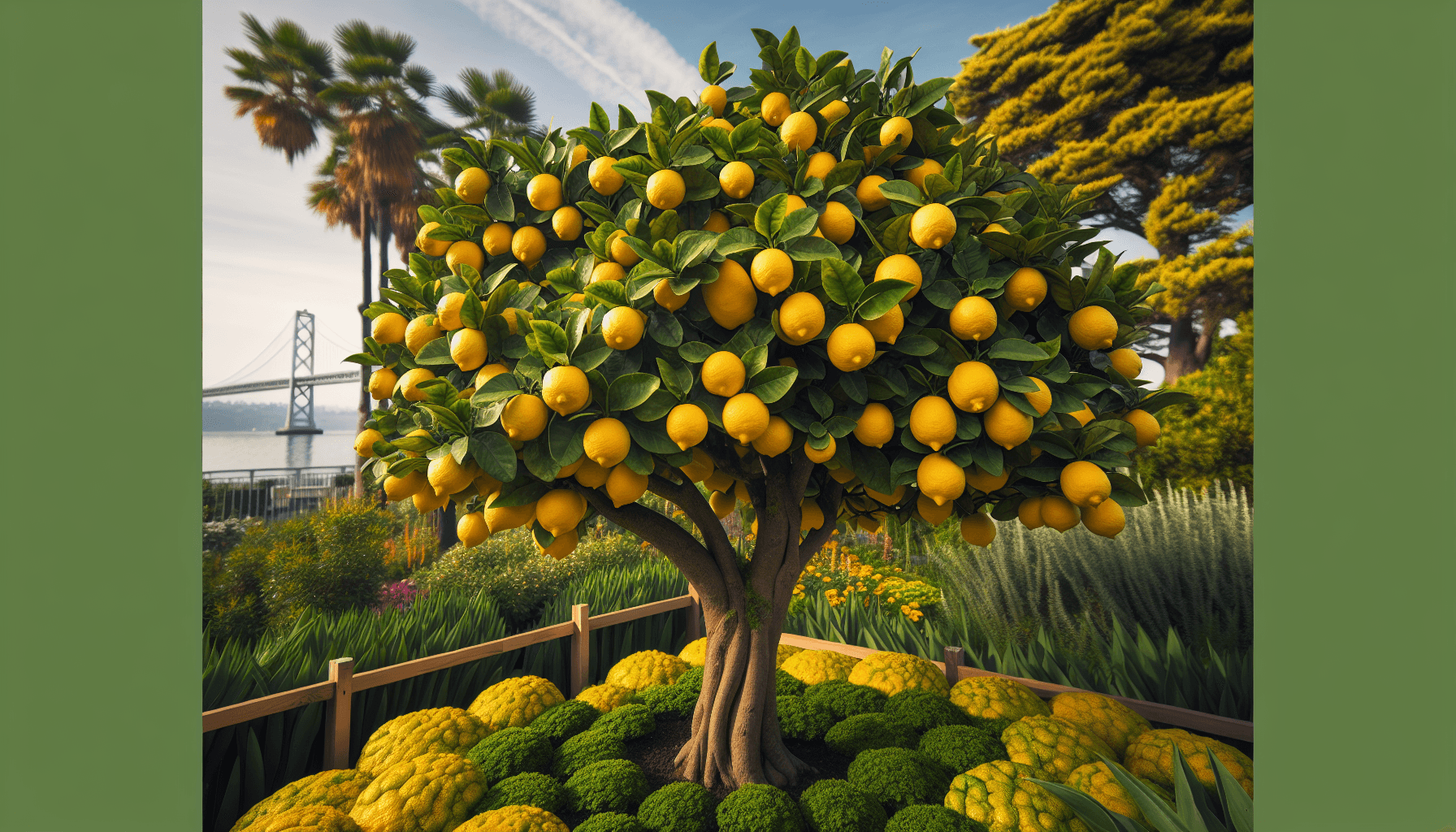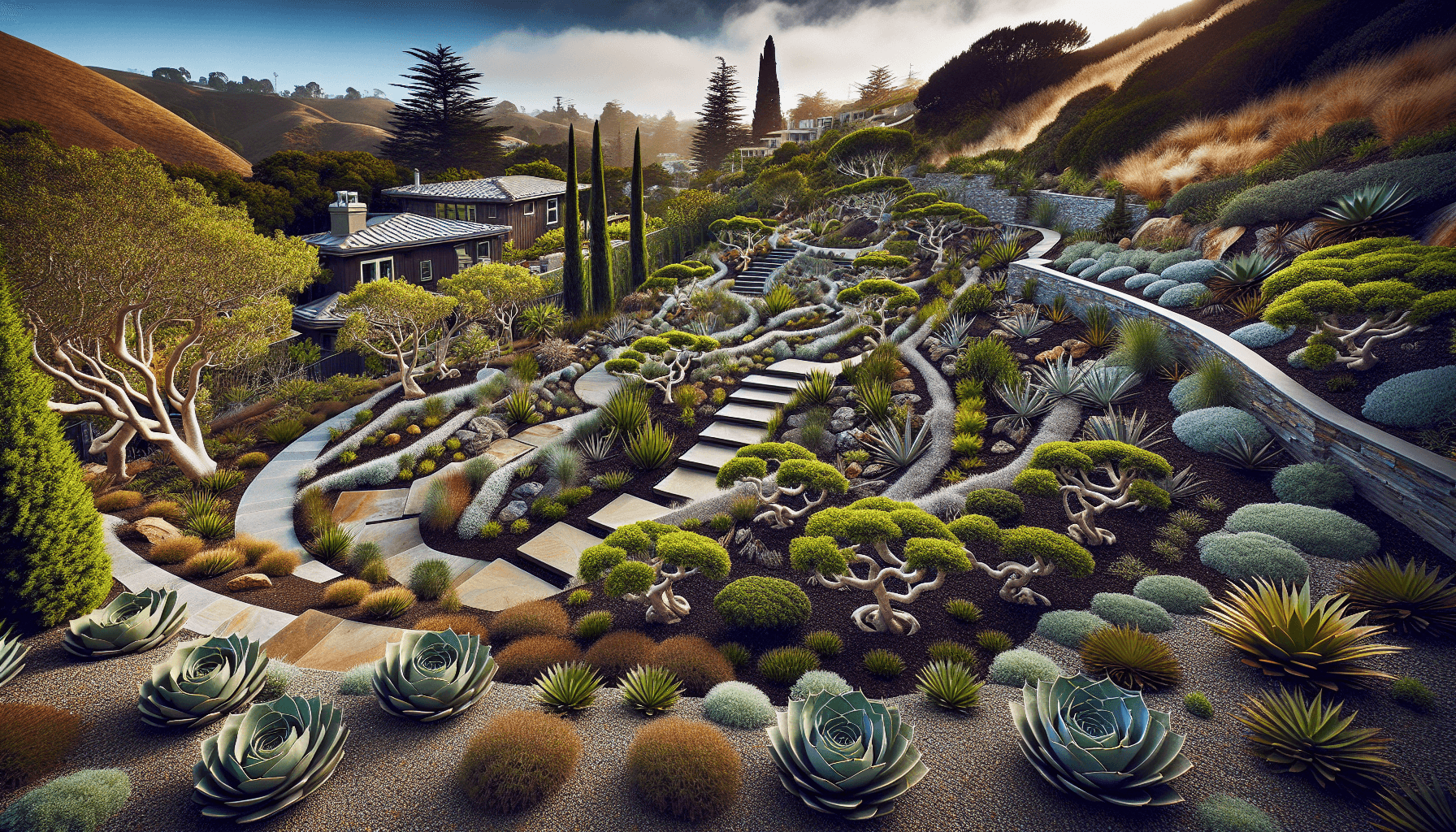Hillside gardens in California offer some of the most spectacular landscaping opportunities—dramatic terraces, sweeping views, and unique planting conditions that transform challenging slopes into stunning outdoor spaces. While sloped terrain presents certain challenges, smart design and the right plants turn these steep sites into gardens that are both beautiful and functional.
From erosion control to creating usable outdoor rooms, hillside gardens require thoughtful planning. This guide will show you how to design terraces, choose slope-loving plants, manage drainage, and create safe pathways that make your hillside garden accessible and maintainable for years to come.
Why Hillside Gardens Are Worth the Effort
While hillside properties come with unique challenges, they offer incredible advantages that flat lots simply can't match:
- Spectacular views that become focal points of your outdoor living spaces
- Natural drainage that moves water away from structures when properly managed
- Vertical dimension that creates dramatic layering and visual interest
- Microclimates that allow you to grow a diverse range of plants
- Privacy as elevation naturally screens views from neighbors
With smart terracing, strategic plant selection, and proper erosion control, a hillside garden becomes a series of outdoor rooms that maximize your usable space while showcasing California's natural beauty.
Terracing & Structural Elements
Retaining Walls & Terraces
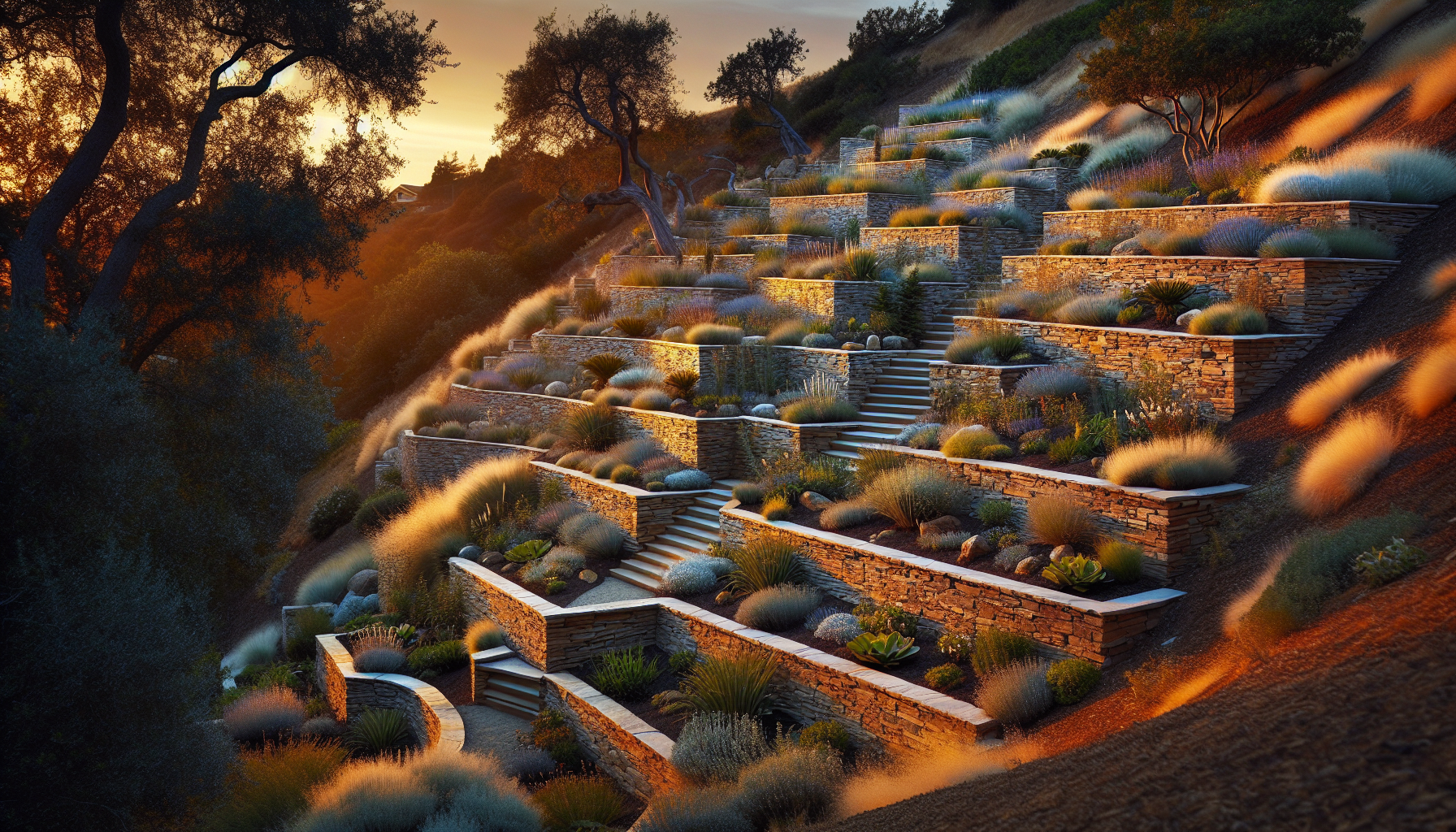
Terraced gardens create usable flat spaces on steep slopes
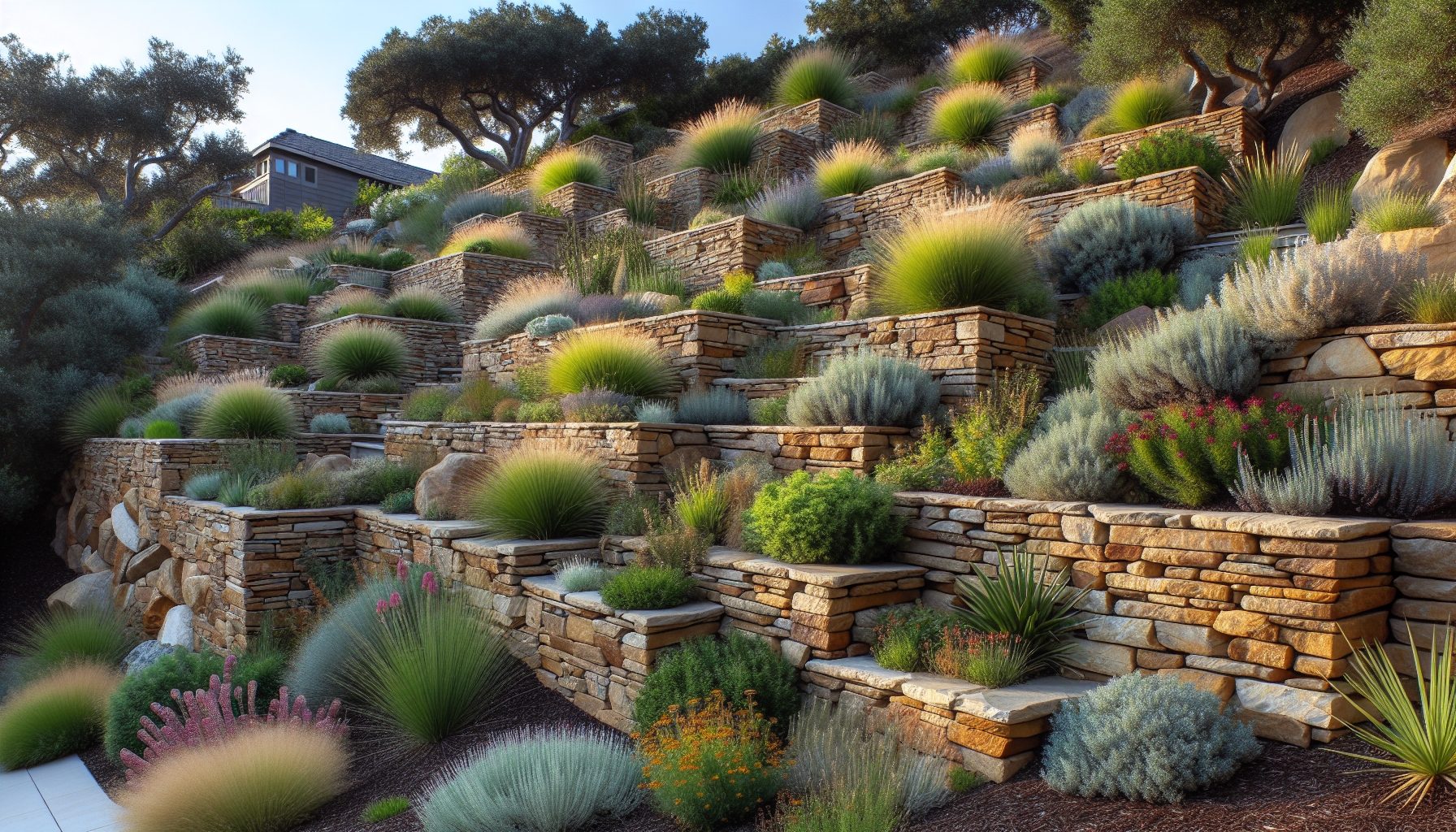
Stacked stone walls provide structure and natural beauty
Retaining Wall Options
Natural Stone
Stacked flagstone or boulders create beautiful, naturalistic walls. Best for walls under 3-4 feet. Provides excellent drainage and ages beautifully. Can be dry-stacked or mortared depending on height.
Concrete Block Systems
Interlocking retaining wall blocks offer strength and variety. Modern systems come in natural stone finishes. Ideal for taller walls requiring engineering. Built-in drainage systems.
Timber Walls
Railroad ties or heavy timbers create rustic, cost-effective retaining. Best for informal gardens. Use rot-resistant species or treated lumber. Good for moderate heights.
Steel Edging
Modern Corten steel or powder-coated edging provides clean lines for contemporary designs. Works well for low walls (8-18 inches). Minimal visual impact.
Pathways & Access
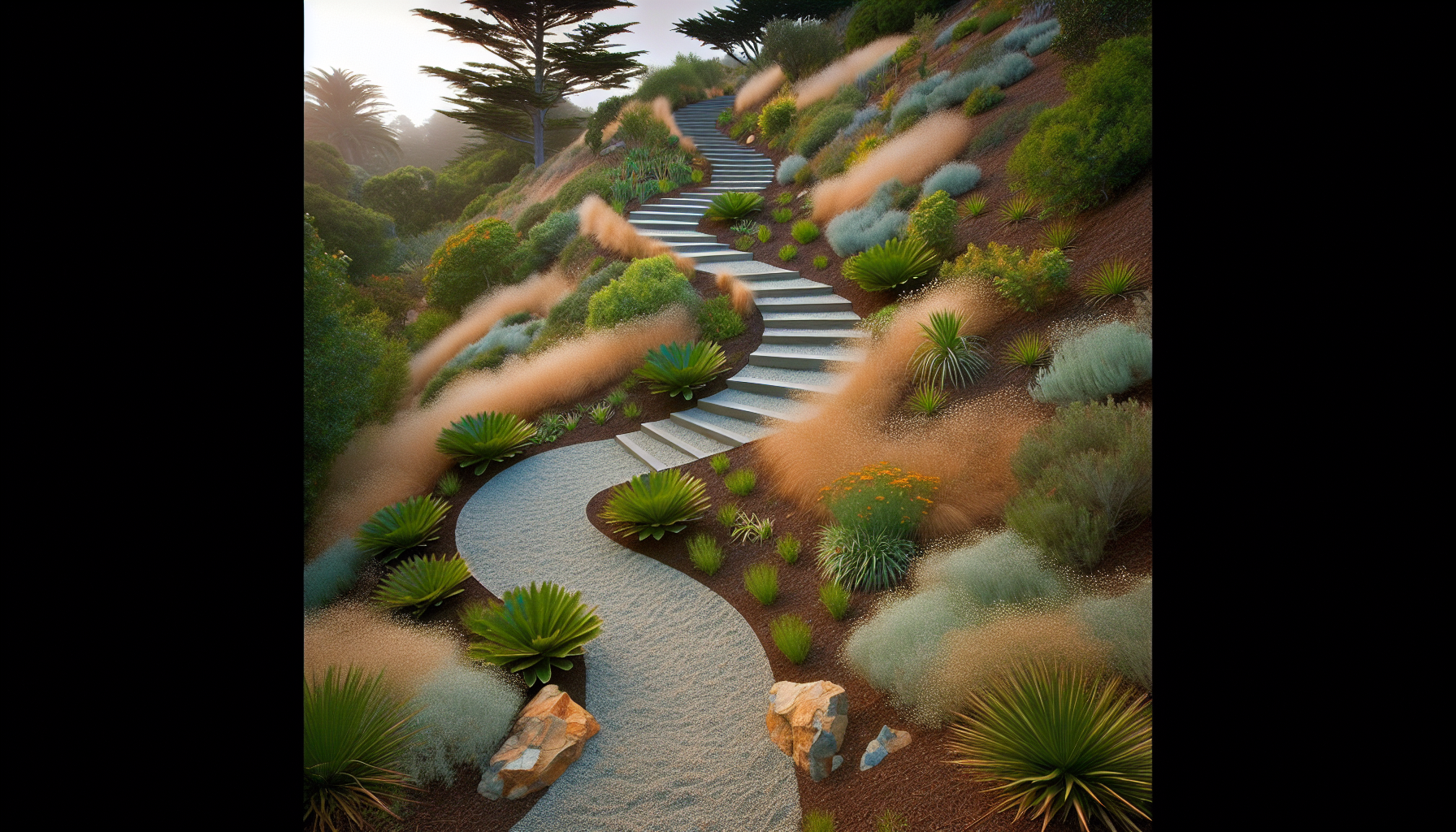
Switchback paths make steep slopes accessible and inviting
Path Design Strategies
Switchbacks
Create gentle zig-zag paths instead of straight climbs. Add landings every 8-12 feet for rest points and visual interest.
Decomposed Granite
Permeable, affordable, and provides good traction. Use stabilized DG for high-traffic areas. Edge with steel or stone.
Steps
Keep risers consistent (6-7 inches) for safety. Use concrete treads, timber, or stone. Add lighting for nighttime access.
Gravel Paths
Natural look with excellent drainage. Choose angular gravel that compacts well. Edging prevents migration downhill.
Erosion Control & Drainage Management
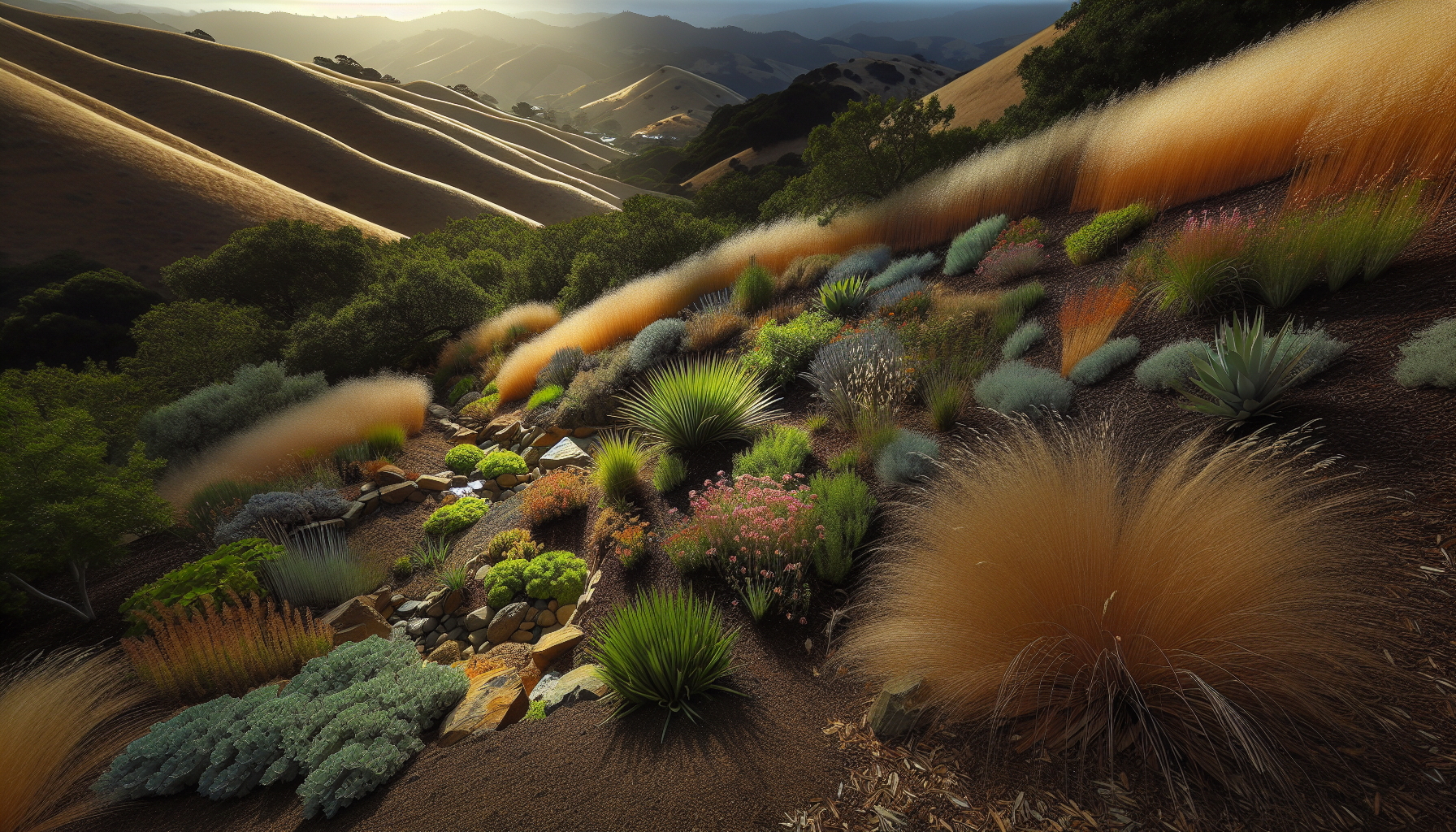
Deep-rooted plants stabilize soil and prevent erosion

Cascading groundcovers knit soil together beautifully
Essential Drainage Solutions
French Drains
Install perforated pipe in gravel-filled trenches at the base of slopes to intercept subsurface water. Prevents water from pooling at foundations and saturating downslope areas.
Dry Creek Swales
Naturalistic rock-lined channels that direct surface runoff safely through the garden. Decorative during dry months, functional during storms. Plant edges with moisture-loving natives.
Terraced Drainage
Each terrace should slope slightly back toward the hillside (2-3%) to prevent water from cascading over retaining walls. Include weep holes in walls every 4-6 feet.
Erosion Control Matting
Biodegradable jute netting or coir mats protect bare soil while plants establish. Stake securely across the slope. Plants grow through the matting, which degrades naturally.
Plant Selection for Slopes
Groundcovers: Soil Stabilizers
Groundcovers are the workhorses of hillside gardens. They knit soil together with fibrous or deep root systems, prevent erosion, and create cohesive carpets that unify the landscape. Choose spreading plants that establish quickly and tolerate drought.
Arctostaphylos 'Pacific Mist'
California native manzanita groundcover. Silvery foliage, pink flowers. Excellent for steep slopes.
Ceanothus 'Yankee Point'
Low-spreading California lilac. Blue spring blooms. Thrives on dry banks.
Dymondia margaretae
Tight silver-green mat. Yellow daisy flowers. Walkable in low-traffic areas.
Erigeron glaucus (Seaside Daisy)
Coastal native with purple flowers. Salt-tolerant. Excellent slope stabilizer.
Carex pansa (Dune Sedge)
Native grass-like groundcover. Forms soft, lawn-like mats. Coastal slopes.
Baccharis 'Pigeon Point'
Coyote brush groundcover. Fast-growing, tough. Great for large slopes.
Shrubs: Structure & Backbone
Slope-Loving Shrubs
Arctostaphylos 'Howard McMinn' (Manzanita)
Sculptural red bark, pink urn-shaped flowers. Upright form (4-6 feet). Excellent on slopes with good drainage. Deep roots prevent erosion.
Frangula californica (Coffeeberry)
Easy native shrub with glossy foliage. Provides year-round structure. Berries attract birds. Adaptable to various slope conditions.
Cistus (Rock Rose)
Mediterranean beauty perfect for sunny slopes. Papery flowers in white, pink, or magenta. Extremely drought-tolerant once established.
Westringia fruticosa (Coastal Rosemary)
Fine-textured evergreen shrub. Wind-tolerant, salt-tolerant. White flowers year-round. Great for coastal hillsides.
Lavandula (Lavender)
Fragrant shrub for sunny slopes. Plant in drifts along terraces. Excellent drainage essential. Prune after flowering.
Salvia (Sage)
Hundreds of varieties for hillsides. California natives and Mediterranean species. Hummingbird magnets with long bloom seasons.
Ornamental Grasses
Grasses add movement, texture, and seasonal interest to hillside gardens. Their extensive root systems stabilize soil while their upright or cascading forms soften hardscaping. Most grasses are extremely drought-tolerant once established.
Muhlenbergia rigens
Deer grass. Architectural clumps with fall flower spikes. Native to California.
Festuca californica
California fescue. Blue-green tufts. Prefers light shade on slopes.
Lomandra longifolia
Tough strappy grass. Clean look. Very slope-friendly and low-maintenance.
Stipa tenuissima
Mexican feather grass. Fine texture, graceful movement. Self-sows gently.
Pennisetum setaceum
Fountain grass. Arching form with feathery plumes. Drought-tolerant.
Carex testacea
Orange sedge. Coppery color. Good for color contrast on slopes.
Accent & Architectural Plants
Strategic placement of architectural plants creates focal points on hillsides. These bold specimens draw the eye and provide structure year-round. Use sparingly for maximum impact.
Agave attenuata
Soft-edged agave perfect for terraces. No spines. Sculptural rosettes.
Aloe hybrids
Succulent leaves with vibrant flower spikes. Drought-tolerant accents.
Phormium (New Zealand Flax)
Sword-like leaves in various colors. Bold vertical statements on slopes.
Yucca species
Dramatic spikes with white flower stalks. Extremely drought-tolerant.
Design Strategies for Hillside Gardens

Design to frame and enhance views from every vantage point
Work with Natural Contours
Don't fight the slope—embrace it. Multiple small terraces are more naturalistic and cost-effective than one massive wall. Follow the land's natural curves when laying out paths and planting areas. This creates a garden that feels organic rather than imposed.
Create Usable Outdoor Rooms
Even on steep slopes, carve out flat "pads" for benches, small tables, or fire pits. A landing halfway up creates a destination and makes the journey feel purposeful. These mini-terraces become observation points for viewing the garden and surrounding landscape.
Plant in Drifts, Not Dots
Mass plantings read better on slopes than scattered individual plants. Group 3, 5, or 7 of the same species to create bands of color and texture that flow across the hillside. This repetition creates unity and makes maintenance easier.
Consider Multiple Viewpoints
Unlike flat gardens viewed from one level, hillside gardens are seen from above, below, and within. Design for these multiple perspectives. Low groundcovers may be invisible from the house—choose plants with visual interest when viewed from above.
Frame Views
Use plantings to frame and enhance distant views rather than blocking them. Place lower plants in sight lines and reserve taller specimens for the edges. Strategic pruning opens "windows" to showcase surrounding landscape.
Irrigation for Slopes
Watering slopes requires special attention to prevent runoff and ensure water reaches root zones. Here's how to irrigate effectively:
Drip Irrigation Across Contours
Run drip lines horizontally across the slope (not up and down) to distribute water evenly. Use pressure-compensating emitters to ensure consistent flow at all elevations. Add check valves at line ends to prevent drainage when system turns off.
Multiple Zones
Top of slope often drains faster than bottom. Create separate irrigation zones for different elevations and exposures. Upper slopes may need more frequent watering; lower areas often retain more moisture.
Low and Slow
Use low-flow emitters (0.5-1 GPH) and water for longer periods. This allows water to soak in rather than run off. Cycle and soak programs—short bursts with breaks between—work well on steep slopes.
Establishment vs. Maintenance
Water new plantings 2-3 times weekly for the first year. Once established (after 2 years), most California natives and drought-tolerant plants need minimal to no summer irrigation on slopes with good natural drainage.
Fire-Smart Landscaping
In fire-prone areas of California, hillside gardens require special consideration. Smart plant choices and spacing create defensible space without sacrificing beauty:
- Zone 0 (0-5 feet from structure): Use mineral materials like gravel, pavers, or decomposed granite. No plant material touching walls.
- Zone 1 (5-30 feet): Low-growing, fire-resistant plants with high moisture content. Space plants to prevent fire from spreading. Remove dead material regularly.
- Zone 2 (30-100 feet): Thin vegetation, remove ladder fuels, create breaks with pathways. Prune lower branches of shrubs and trees.
- Avoid continuous hedges: Create gaps between shrub masses with DG ribbons or pathways to prevent fire from moving through plantings.
- Choose fire-resistant plants: Succulents, groundcovers like dymondia, and natives with high moisture content. Avoid highly flammable species.
- Maintain regularly: Clean leaf litter, prune dead branches, and keep vegetation groomed, especially before hot, windy periods.
Seasonal Maintenance
Winter-Spring
Best planting season for woody shrubs and California natives. Roots establish during rainy months, reducing summer water needs. Check drainage systems before first rains. Clear debris from swales.
Late Spring
Cut back deer grass 6-8 inches from base. Shear lavender after flowering. Lightly shape rockrose and westringia. Apply fresh mulch to bare areas before heat arrives.
Summer
Spot-water new plantings. Sweep steps and pathways. Refresh DG where needed. Monitor for erosion during any summer storms. Many established plants need no supplemental water.
Fall
Top up gravel mulch. Plant wildflower seeds in open pockets. Check French drains and swales before winter rains. Stake any erosion control matting that has shifted.
Budget Considerations
Hillside gardens vary widely in cost depending on the extent of grading, retaining walls, and accessibility. Here's a general framework:
Basic Improvements (Under $5,000)
Simple switchback DG path, erosion control matting on bare areas, 30-40 one-gallon slope plants, basic two-zone drip irrigation. DIY-friendly with careful planning.
Mid-Range Installation ($15,000-$40,000)
Proper stairs with landings, low retaining walls (under 4 feet), professional boulder placement, comprehensive planting plan, multi-zone irrigation, path lighting. Creates fully functional outdoor space.
Engineered Solutions ($60,000+)
Tall retaining walls requiring structural engineering, hillside decks with railings, integrated drainage systems, extensive terracing, built-in seating, outdoor lighting systems. Long-term investment in usability and property value.
Note: Walls over 3-4 feet typically require engineering and permits. While this adds upfront cost, proper engineering ensures long-term safety and stability. Factor in professional consultation for steep slopes or complex drainage situations.
Getting Started
Your Hillside Garden Journey
-
1.
Assess Your Slope
Determine grade percentage, identify existing drainage patterns, note erosion areas. Take photos from multiple angles and elevations.
-
2.
Plan Access First
Design pathways and stairs before selecting plants. Safe access makes everything else possible, including maintenance.
-
3.
Address Drainage
Install French drains or swales before planting. Proper drainage prevents future erosion and foundation problems.
-
4.
Start with Groundcovers
Stabilize soil quickly with erosion-control plants. Mass groundcovers establish faster than larger specimens and provide immediate soil protection.
-
5.
Add Structure Gradually
Layer in shrubs and accent plants once groundcovers are established. This allows you to refine your design as the garden matures.
-
6.
Plant in Fall
Fall planting allows roots to establish during winter rains, minimizing irrigation needs during the first summer.
Hillside gardens transform California's challenging topography into spectacular outdoor spaces that celebrate vertical drama, frame views, and create unique microclimates. With thoughtful terracing, strategic plant selection, and proper erosion control, your slope becomes an asset rather than a limitation.
Start with safe access and solid drainage, then layer in plants that stabilize soil while providing year-round beauty. Whether you're creating a simple native slope garden or an elaborate terraced retreat, the key is working with the land's natural contours. Your hillside garden will reward you with dramatic views, diverse growing conditions, and a landscape that feels truly integrated with California's natural terrain.

